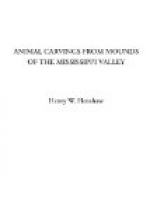By its discovery and description the interesting question was raised as to the contemporaneousness of the Mound-Builder and the mastodon, an interest which is likely to be further enhanced by the more recent bringing to light in Iowa of two pipes carved in the semblance of the same animal, as well as a tablet showing two figures asserted by some archaeologists to have been intended for the same animal.
Although both the mound and pipes have been referred in turn to the peccary, the tapir, and the armadillo, it is safe to exclude these animals from consideration. It is indeed perhaps more likely that the ancient inhabitants of the Upper Mississippi Valley were autoptically acquainted with the mastodon than with either of the above-named animals, owing to their southern habitat.
Referring to the possibility that the mastodon was known to the Mound-Builders, it is impossible to fix with any degree of precision the time of its disappearance from among living animals. Mastodon bones have been exhumed from peat beds in this country at a depth which, so far as is proved by the rate of deposition, implies that the animal may have been alive within five hundred years. The extinction of the mastodon, geologically speaking, was certainly a very recent event, and, as an antiquity of upwards of a thousand or more years has been assigned to some of the mounds, it is entirely within the possibilities that this animal was living at the time these were thrown up, granting even that the time of their erection has been overestimated. It must be admitted, therefore, that there are no inherent absurdities in the belief that the Mound-Builders were acquainted with the mastodon. Granting that they may have been acquainted with the animal, the question arises, what proof is there that they actually were? The answer to this question made by certain archaeologists is—the Elephant Mound, of Wisconsin.
[Illustration: Fig. 27.—The Elephant Mound, Grant County, Wisconsin.]
Recalling the fact that among the animal mounds many nondescript shapes occur which cannot be identified at all, and as many others which have been called after the animals they appear to most nearly resemble, carry out their peculiarities only in the most vague and general way, it is a little difficult to understand the confidence with which this effigy has been asserted to represent the mastodon; for the mound (a copy of which as figured in the Smithsonian Annual Report for 1872 is here given) can by no means be said to closely represent the shape, proportions, and peculiarities of the animal whose name it bears. In fact, it is true of this, as of so many other of the effigies, the identity of which must be guessed, that the resemblance is of the most vague and general kind, the figure simulating the elephant no more closely than any one of a score or more mounds in Wisconsin, except in one important particular, viz, the head has a prolongation




